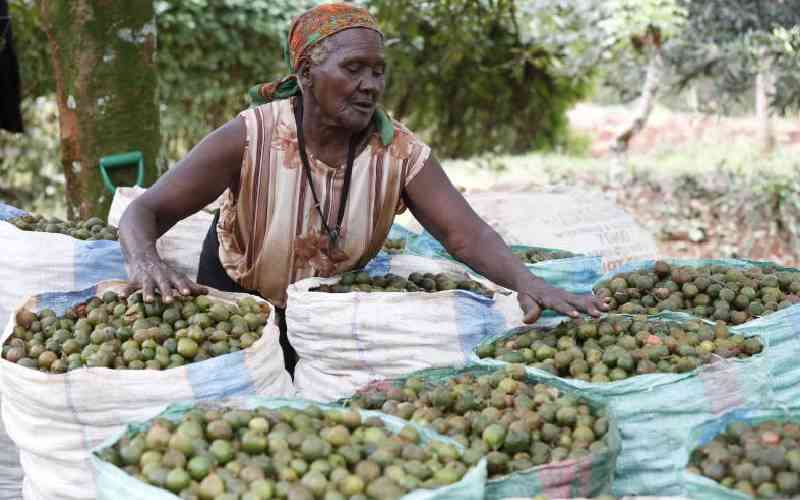By JACKSON OKOTH
Kenya’s top five banks made enviable returns last year from every person who walked through their doors to make a deposit.
If one totals the gross profits KCB, Equity Bank, Barclays Bank of Kenya, Co-operative Bank and Standard Chartered Bank made, the institutions raked in Sh13 in profit for every Sh100 deposited last year.
And this profit is what has got debate raging in private sector circles as well as in Government on how banks can reduce their interest rate spreads — the difference between what they pay depositors and what they charge for their loans — to make credit affordable.
Large banks are able to mobilise cheap deposits from the public, which they then lend on at double-digit rates.
Although they maintain that they have to have large spreads to cover themselves from risky borrowers, the entry of credit reference bureaus should provide a reprieve. But whether or not it will remains to be seen.
Mobile banking has also helped reduce the cost of deposits. Banks have been saved the massive investment required in brick and mortar as mobile phones can now be used to open accounts, deposit cash, make withdrawals and even apply for loans. Agency banking has additionally eased staffing costs.
Most profitable
Available figures indicate that the top five banks made a combined gross profit of Sh73.91 billion. This is against total deposits of Sh963 billion.
The customer deposits for the entire banking industry as at December last year stood at Sh1.98 trillion.
Kenya’s banking business may well be considered the most profitable to be in, with one of the highest net interest margins in the world.
“With a deposit rate of between four and six per cent, most banks will charge upwards of 18 per cent on their loan products. It is this huge spread that is driving up their profits,” says Mr Aly Khan Sachu, an analyst at Richmond Management.
Commercial banks offer retail investors an average four per cent deposit rate, though institutional investors can demand rates as high as 12 per cent.
Yet, the bulk of the revenue for most of the top five banks came from retail customers.
The poor returns for the savers, compared with other investment options such as the equities market that recorded double-digit growth last year, have discouraged many from keeping their hard-earned cash in banks.
More worrying is the fact that with inflation at between seven and eight per cent, and deposit rates not matching this, the value of the money kept in financial institutions is dropping.
Manoeuvre minefields
Compare banking to another billion-shilling industry — telecoms.
Investors have long regarded telecoms as a perfect commodity business (one where you must have the lowest costs to survive).
Safaricom, the dominant player in this sector, is the only firm outside banking circles that dwarfs the profits banks make.
The firm registered a gross profit of Sh25.5 billion for its financial year ended March 2013 from revenues of Sh124.3 billion. This means it made about Sh20 before tax from every Sh100 its 19.4 million subscribers spent.
In a perfectly competitive country, margins like that would attract new players with new capital. That is what happened in the sector in 2008 and currently, and we know how the sector’s margins and return on equities went into a free-fall as a result of price wars.
Businesses sporting artificially high margins never last too long in Kenya, but Safaricom has managed to manoeuvre minefields to retain its top position and high returns with innovative products that have kept it ahead of the pack.
Banking is even more of a commodity business than telecoms. A depositor has little interest in a bank’s brand value. As long as, broadly, the bank meets the sniff test of safety, a depositor will settle for whichever institution offers the best rates on deposits.
On the borrowing side, a borrower cares even less about the lending bank’s brand value. He is merely interested in getting the lowest rates and fastest approvals for his loan.
Opening a bank branch is easy; there are no great complexities of technology required. Each bank can easily duplicate what the next one is doing, and there is near zero product differentiation.
But given the low deposit rates offered to customers, those who are more savvy are seeking alternative investment vehicles to grow their cash.
And while banks now have more access to prospective borrowers’ credit history, this has yet to be reflected in the interest rates charged for loans.
“In the recent past, the law only allowed banks to share credit information on bad borrowers. But now, banks are also sharing details on the good borrowers. This is where the true worth of the credit referencing system lies,” says Mr Habil Olaka, the CEO of Kenya Bankers Association.
He added that while spreads in the industry are an issue of concern, the margins have been dropping.
A committee has also been formed at the National Treasury to look into why banks have low deposit rates, and find solutions to the constraints facing them.
Higher pricing
The list of sectors and businesses said to be suffering the weight of costly credit include real estate developers, manufacturers and transporters.
“Expensive credit has had an impact on our input costs, leading to higher pricing. This continues to make home ownership unreachable to the majority of Kenyans,” said Mr Daniel Ojijo, the CEO of real estate firm VillaCare.
Officials from the World Bank have observed that while the real estate sector is witnessing a boom of new developments, banks are not financing these activities. Instead, developers are relying on other sources, such as diaspora remittances, to finance their projects.
“Expensive credit limits the entry of more businesses into the market, denying the country the opportunity to create more jobs and wealth. Costly credit also reduces the volume of new investments as well as the expansion of existing ones,” says Ms Carol Kariuki, the CEO of the Kenya Private Sector Alliance.
But what spread would work for all players?
According to Mr John Randa, a senior economist at the World Bank, one between five and six per cent.
But there are analysts who see current bank profits as a signal that Kenya’s economy is doing well.
“The demand for credit remains strong, hence an increase in its supply. Banks are satisfying this demand if their profitability is anything to go by,” says Dr Gerrishon Ikiara, a senior lecturer at the Institute of Development Studies at the University of Nairobi.
Dr Ikiara argues that lenders are generally not in the business of easing access to credit, but making the most out of the prevailing supply and demand conditions.
“Good profits by banks are a good barometer of how the economy is doing. There is no credit crisis and the markets seem to be working just fine.”
To put these varying sentiments in perspective, Business Beat analysed the 2013 financial results the top five banks released in the last couple of months.
Kenya Commercial Bank
The bank made a pre-tax profit of Sh20.1 billion last year, which saw it become Kenya’s most profitable bank. However, its staff costs were also the highest at Sh13.6 billion.
The bank had the highest customer deposits at Sh287.3 billion. In second place was Equity Bank, with Sh194.6 billion in deposits.
“[KCB] has a long institutional memory and is a strong East African brand. The bank also has new market knowledge and less Government of Kenya business than before,” says Mr Kariithi Murimi, the patron of the Institute of Credit Management.
According to a Standard Investment Bank (SIB) commentary, KCB’s other strength is its recently assembled senior executive team that seems to have gelled well.
“We remain optimistic that the team will sustain the bank’s transformative momentum, pivoted around product innovation and improved staff productivity.”
KCB’s results also show it had the largest loan book at the close of December 2013, with net loans and advances at Sh227.7 billion, and the largest portfolio of Government securities at Sh93 billion.
The management attributed the bank’s performance to a “favourable” business environment.
Chief Executive Joshua Oigara said that the bank registered growth in all its business segments. These include transaction-based income and regional subsidiaries.
International business in Southern Sudan, Uganda, Tanzania, Rwanda and Burundi contributed 11.5 per cent to the group’s profit.
Revenues from these regional subsidiaries surged 60 per cent to Sh2.4 billion, from Sh1.5 billion the previous year.
Mr Oigara told an investor briefing that the bank plans to grow non-funded income through cross-selling and optimal utilisation of alternative channels such as agency banking, mobile banking, Internet banking, automated teller machines (ATMs) and credit cards.
Equity Bank made a pre-tax profit of Sh19.2 billion. It registered weak performances from its subsidiaries in South Sudan (which saw renewed clashes break out in December last year) and Uganda, and flat profit levels in Tanzania and Burundi, which pushed it to second place.
“These subsidiaries are maturing and have stabilised, and we are confident after breaking even in Tanzania after only two years,” says the bank’s CEO, Dr James Mwangi.
Its South Sudan operations hold a Sh17 billion balance sheet, with Sh5 billion in loans. The bank made a Sh700 million provision to cover possible losses.
Equity shareholders have expressed concern over the bank’s widening portfolio of non-performing loans (NPLs), which moved up from 3 per cent to 5 per cent of the overall loan book. The industry average is 9 per cent.
“We were forced to lend above inflation when it was around 19.8 per cent, with interbank rates hovering around 28 per cent. But the Central Bank Rate is down to 8 per cent and we have also lowered our rates. This was a spike, and individuals and businesses are adjusting,” says Dr Mwangi
Equity Bank has cutting-edge products that connect to customers, but it rides on Mwangi’s energy.
“Equity has a strong balance sheet, which is a strength. However, its weakness lies in what is a clear lack of a succession plan for Dr Mwangi as well as the bank’s overexposed loans,” says Mr Murimi.
But the SIB research note adds: “With competition in the banking sector shifting more towards product innovation, leveraging on technology and speed to market, on all three fronts, Equity Bank remains the bank to beat.”
STANDARD CHARTERED BANK
The British multinational emerged the most profitable foreign-based bank, ahead of close rival Barclays Bank of Kenya. Its pre-tax profit for 2013 was Sh13.4 billion.
It is also Kenya’s most efficient bank in terms of cost-income ratio. It has the advantage of size and sophistication to play in the country’s emerging areas such as the oil and gas industry, and continues to maintain a healthy balance between its consumer and wholesale divisions.
Consumer banking accounted for 46 per cent of total income. On this front, SCB has over the past two years aggressively acquired market share by refinancing personal check-off loans by offering lower interest rates.
“On the consumer banking side, the growing middle class clearly is an area that plays into our focus in terms of strategy, therefore, we see the outlook for 2014 as being quite positive,” says CEO Lamin Manjang.
On wholesale banking, the management said it would remain focused on growing both short-term and long-term loans.
SIB says that although it expects the bank’s loan and deposits to grow in line with the sector average, it will come as no surprise if earnings growth remains above sector.
“We expect no major changes in strategy following the appointment of a new CEO in December 2013 (as a positive, the new CEO has committed to engaging with investors more),” note the analysts.
And while KCB and Equity rely on their huge local and regional networks and customer bases, SCB has matched these strengths with an equally huge balance sheet valued at Sh220 billion and a global presence.
Its loan book grew to Sh129.7 billion from Sh112.7 billion in 2012, with customer deposits rising to Sh154.7 billion from Sh140.5 billion.
The amount of cash that was put in Government paper — a lucrative avenue for most banks — rose to Sh53.1 billion by December 2013, up from Sh42.4 billion in 2012.
Total operating costs hit Sh9.5 billion as the bank pumped more cash into infrastructure, technology and talent to support its growth.
In addition to oil and gas, SCB plans to turn its attention to power generation projects and upgrading of the various transport networks to drive its wholesale banking business this year.
It will also expand its Internet and mobile banking platforms. It has a firm grip on liquidity and capital as well as global capabilities and asset quality to drive up its business performance.
BARCLAYS BANK OF KENYA
BBK’s pre-tax profit fell to Sh11.13 billion in 2013 from Sh13.02 billion the previous year.
The management attributed the performance to a one-off restructuring cost amounting to Sh788 million, an increase in loan impairment charges and the slowdown in economic activities during the first half of last year as a result of the March General Election.
But even as shareholders and analysts digested the depressing figures of a once top-performing lender, the management hinted at better prospects this financial year.
Analysts maintain that BBK has a long history in Africa and cannot be overlooked.
“For a long time, the bank has been run from the UK head office, which is out of sync with BBK. This has been a drag on the bank. But the establishment of an African office and strategy could change things for it,” said Mr Satchu.
And with BBK’s performance lower than expected, SIB forecasts it will continue to lag the sector in earnings and assets growth.
BBK is expected to roll out bancassurance and leverage on its investment arm ABSA’s expertise to develop and grow its investment banking fees.
The UK-based bank is also expected to exploit its strong credit card franchise to grow customer loyalty as the competition to acquire customers who can absorb multiple products intensifies.
CO-OPERATIVE BANK OF KENYA
Considered Kenya’s third largest bank in assets, Co-op Bank’s pre-tax profit rose to Sh10.51 billion from the previous year’s Sh9.98 billion.
As the gatekeeper for the co-operative movement, this market has given the institution a competitive advantage.
The bank’s top management attributed the performance to an increased inflow of revenues from banking transactions and the group’s diversified product offerings.
Chief Executive and Managing Director Gideon Muriuki described the performance as “satisfactory”, given the year’s difficult operating environment particularly in respect to the political jitters in the run up to the March 4 polls and the political instability in South Sudan.
“With major investments in branch network, ICT infrastructure and new operations in South Sudan, we expect the growth momentum to be sustained and better profitability in 2014,” Mr Muriuki told an investor briefing.
Co-op is also seen as having no clear succession plan for its CEO, and its loan book is thought to be too invested in co-operatives.
Financials for 2013 indicate that the bank’s customer deposits increased 11 per cent to Sh180.9 billion from Sh163.1 billion the previous year, while net loans and advances surged 15 per cent to Sh137.1 billion from Sh119.1 billion.
Its net interest income grew 19 per cent to Sh18.6 billion from Sh15.7 billion in 2012, while non-interest income rose 13 per cent to Sh9.3 billion from Sh8.2 billion.
Growth in non-funded income (non-interest income) was occasioned by increased fees and commissions on ATM transactions, personal and business banking, agency banking, mobile banking, Internet banking, forex and letters of credit.
The group’s total assets now stand at Sh231.2 billion, while the number of account holders rose 28 per cent to 4.1 million from 3.2 million in 2012.
Co-op Bank currently boasts a larger customer base than KCB, and on paper, it has better prospects of securing the micro and SME business given its Sacco background.
The bank’s profitability has more than tripled over the last six years, rising by 223.51 per cent to Sh10.87 billion in 2013 from Sh3.36 billion in 2008.
This has been attributed to the bank’s heavy investment in ICT, human capital and adoption of a prudent risk management framework to cut down on the level of NPLs.
However, its balance sheet growth was disappointing, with both loan and deposit growth missing forecasts.
And though it outperformed KCB on both loan and deposit growth, it lagged Equity Bank on both measures.
Also, contributions from the bank’s two key lending segments (personal check-off and corporate) declined to 38 per cent and 13 per cent of total revenue, while lending to Saccos and SMEs expanded to 21 per cent and 9 per cent of revenue.
If it builds a larger, all-inclusive banking franchise, SIB views Co-op as gradually emerging as a first-option bank as opposed to an alternative to KCB and Equity.
[email protected]
 The Standard Group Plc is a multi-media organization with investments in media
platforms spanning newspaper print operations, television, radio broadcasting,
digital and online services. The Standard Group is recognized as a leading
multi-media house in Kenya with a key influence in matters of national and
international interest.
The Standard Group Plc is a multi-media organization with investments in media
platforms spanning newspaper print operations, television, radio broadcasting,
digital and online services. The Standard Group is recognized as a leading
multi-media house in Kenya with a key influence in matters of national and
international interest.
 The Standard Group Plc is a multi-media organization with investments in media
platforms spanning newspaper print operations, television, radio broadcasting,
digital and online services. The Standard Group is recognized as a leading
multi-media house in Kenya with a key influence in matters of national and
international interest.
The Standard Group Plc is a multi-media organization with investments in media
platforms spanning newspaper print operations, television, radio broadcasting,
digital and online services. The Standard Group is recognized as a leading
multi-media house in Kenya with a key influence in matters of national and
international interest.









